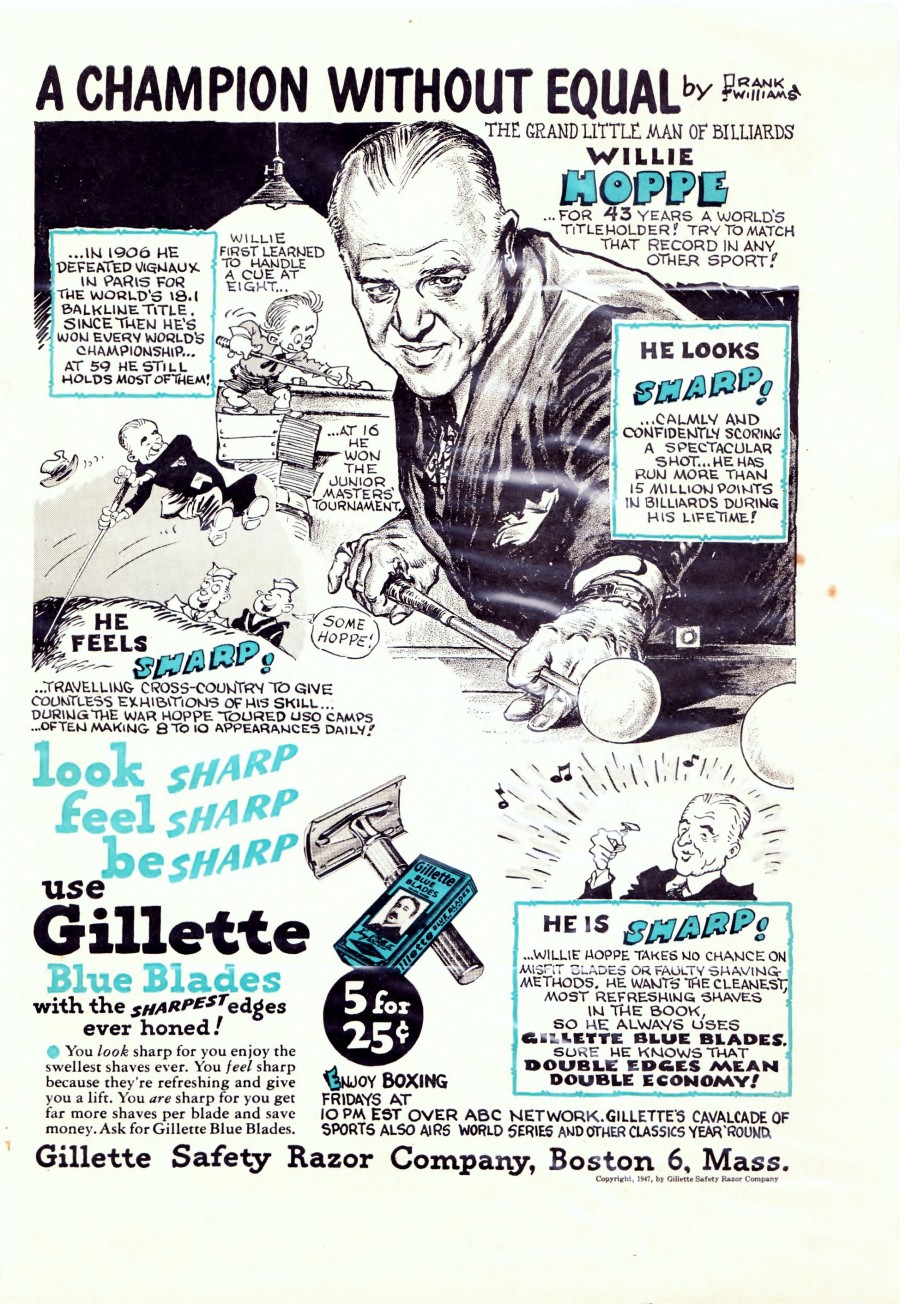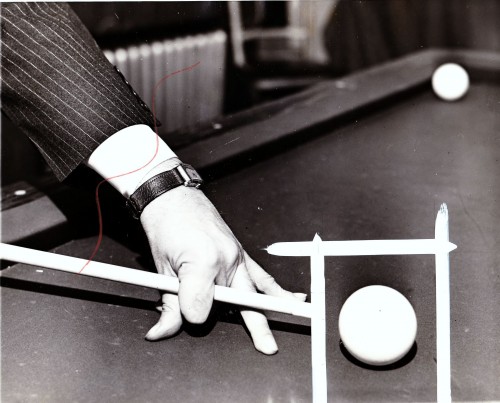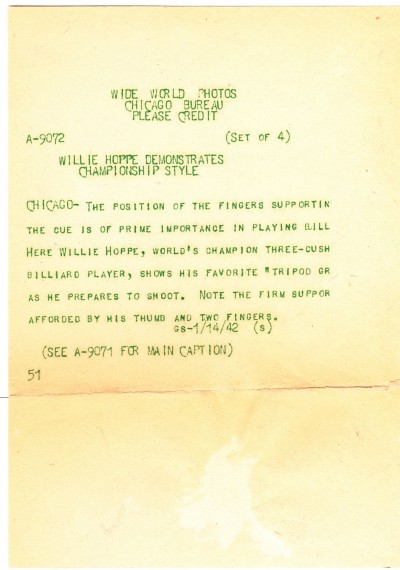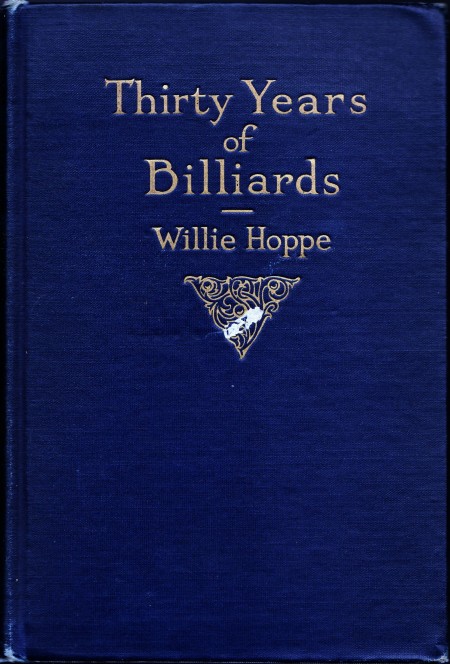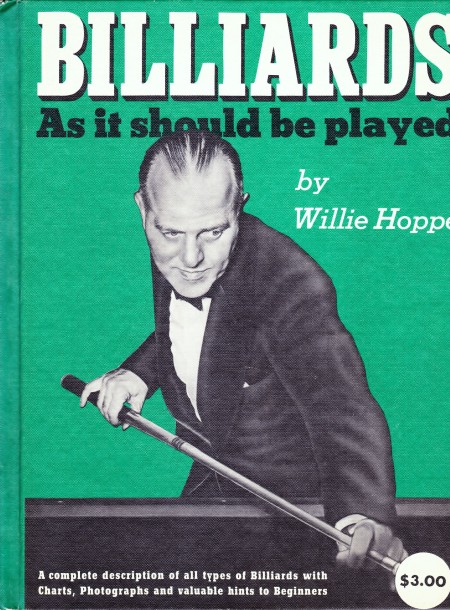Willie Hoppe, Mr. Billiards.
50 Jaar biljartgeschiedenis geschreven door 1 man. 50 Years of billiards history written by 1 man.
Vanaf 1933 tot 1952 trokken Willie Hoppe en Welker Cochran het driebandlaken in de U.S. volledig naar zich toe. Hoppe’s naam en faam in het carambolespel, het carom billiards, was echter al veel eerder gemaakt. Voor die tijd was hij al meerdere malen tot wereldkampioen bij de professionals gekroond in het kaderspel. Deze wereldkampioenschappen voor profs waren een Amerikaans onderonsje slechts sporadisch verstoord door een buitenlander zoals de de Antwerpenaar Edouard Horemans. De bijnaam van Willie Hoppe was Mr. Billiards. Zijn ganse leven zou in het teken van het biljarten staan.
From 1933 onwards to 1952, Willie Hoppe and Welcher Cochran dominated 3-cushion billiards in the U.S.A. Hoppe's name and fame in carom billiards was established much earlier as he did win many world titles in the balkline division. These world championships for professional players were mostly organised in the U.S. and contenders were generally American players. From time to time a European would spoil the party like Belgian Edouard Horemans from Antwerp. Willie Hoppe's nickname was Mr. Billiards. As from his childhood billiards would be the one constant factor in his life.
William Frederick Hoppe werd geboren op 11 oktober 1887 te Cornwall Landing aan de oevers van de Hudson, niet ver van New York. Vader Frank (°1863) was kapper en aansluitend aan de kapperszaak hield moeder Frances (°1867 Hoffman) een lunchroom open. In de zaak stond een pooltafel. De kleine Willie zou vanaf zijn 5 jaar met het spelletje kennismaken en samen spelen en oefenen met zijn 2 jaar oudere broer Frank (°1885). Opa Hoffman maakte een houten bankje voor de kleine Willie en kon hij dan nog niet aan de bal dan ging hij op de biljarttafel liggen met zijn voeten onder de kerosine lampen. Aan dit spelen op jonge leeftijd hield Hoppe zijn karakteristieke zijdelingse afstoot over. Willie had nog 3 zussen Verena (°1889), Lillian (°1893) en Irma (?) en een jongere broer Albert (°1891).
William Frederick Hoppe was born on October 11 1887 in Cornwall Landing at the Hudson river, not far from New York. Father Frank (°1863) was a barber. Mother Frances (°1867 Hoffman) kept a lunchroom alongside the barbershop. The lunchroom held a pool table. Little Willie would already start playing billiards as from the age of 5 together with his older brother Frank (°1985). Granddad Hoffman made Willie a wooden box to stand on, if then he still could not reach the balls he would lay down on the tables, his feet in the air under the kerosine lamps. Playing from such a young age as a little boy resulted in his characteristic "side stroke" that would stay with him until the end of his career. Willie had 3 sisters Verena (°1889), Lillian (°1893) and Irma (?) and a younger brother Albert (°1891).
Foto/Photo : De jonge Willie Hoppe (schatting ~1910) - Young Willie Hoppe (estimate ~1910)
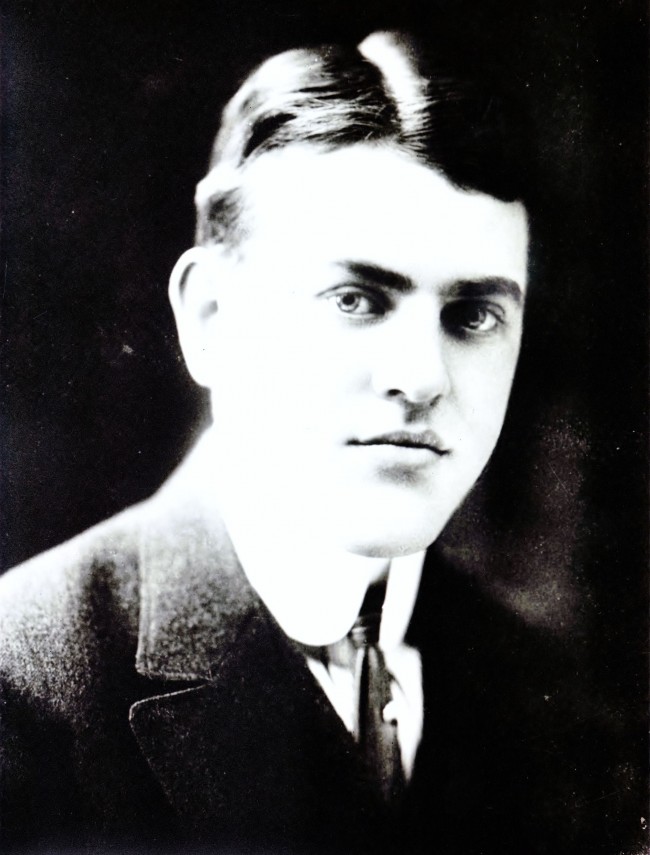
Vader Hoppe zag brood in het biljarttalent van zijn twee oudste zonen en ging in 1895 met hen op tour in de staat New York voor een aantal demonstratiewedstrijden. Wanneer er onvoldoende interesse was trachtte hij de klanten van de lokale biljartzaak te verleiden tot een wedstrijd om geld. Vanaf dat moment werden ze verplicht ernstig te trainen onder vaders alziend oog die hen in het Duits onderrichtingen gaf of een tik om de oren als het resultaat ondermaats was. In zijn eerste boek "Thirty Years of Billiards" dat in 1925 verscheen zou Willie die tikken plastisch omschrijven als "a soundbox".
Father Hoppe reckoned he could earn a living with the talent of his 2 eldest sons and would start touring the state of New York to play exhibition matches. When there was little local interest he would lure customers of the local pool room into matches for money with his sons. As from that time on their father obliged his sons to train daily. Father would instruct them in German and would give them a "soundbox" against the ears if the result did not satisfy him, as Willie described it in his book "Thirty Years of Billiards" published in 1925.
Het talent was Maurice Daly, ex-wereldkampioen en uitbater van 2 biljartzaken in New York City, ter ore gekomen die hen uitnodigde voor een aantal partijen. Daly maakte vader er opmerkzaam op dat Willie meer aanleg had voor het carambolespel dan voor het poolbijarten. Van die dag nam de carrière van Willie een nieuwe wending. Al snel maakte hij series van meer dan 300 caramboles in het vrijspel en 30 over band. Vader verkocht de zaak en zou zich full time bezighouden met de carrière van zijn jongste zoon. Broer Frank had er de brui aan gegeven.
Maurice Daly, the old world champion and owner of 2 billiard rooms in New York, heard the rumours about this young talent and invited him over to play some matches. Daly pointed out to father Hoppe that Willy had a natural talent for carom billiards more than for pool billiards. This advice would turn around Willie's career. Soon we would score series of 300 caroms in straight rail and over 30 in 1-cushion play. Father sold the family's business and would take full time care of his son's career. Brother Frank quit playing.
Foto/Photo : Willie Hoppe krijgt op 11-jarige leeftijd (1898) les van Maurice Daly - 11-year old Willie (1898) teached by Maurice Daly
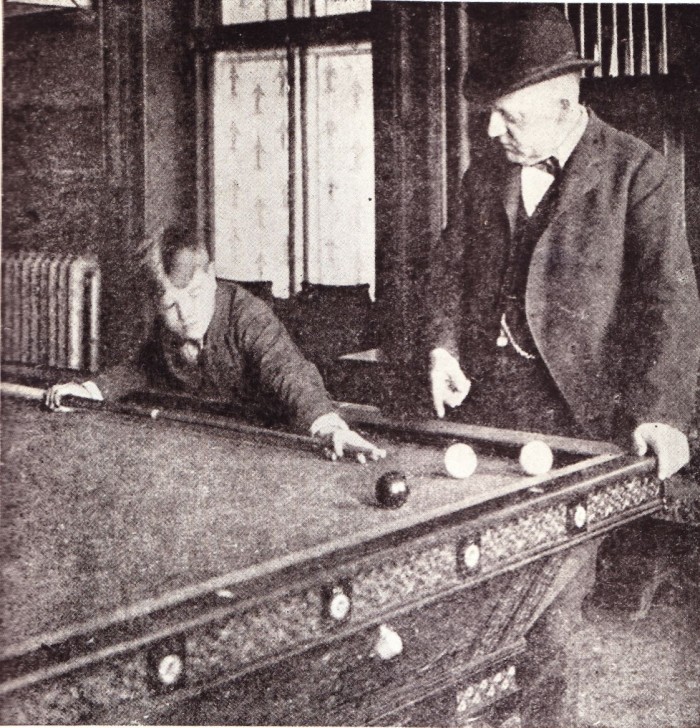
Tijdens exhibities in Chicago in de winter van 1897-1898 ontmoette de jonge Willie Frank Ives, een briljant biljarter en all-round atleet die voordien al uitblonk in het rolschaatsen, wielrennen, baseball en paardrijden. Frank Ives leerde Willie hoe hij in het vrijspel en kader de biljartballen aan de kop van de biljart kon houden. Ives zou jong sterven aan een liederlijk leven. Vader peperde Willie in om nooit een druppel alcohol te nuttigen. Een raad die hij zijn ganse sportcarrière zou volgen.
During exhibitions in Chicago in the winter of 1897-1898 young Willie met with Frank Ives, a brillant billiards player and an all-round athlete. Ives already made a name in rolerskating, cycling, baseball and horse riding. Ives teached Willy how to keep the balls at the head of the table, a very important feature in order to build long runs in straight rail and balkline. Ives who lived a fast life would die young. Something his father used to imprint Willie never to drink a drop of alcohol, an advice he followed during the whole of his sporting career.
Op 14-jarige leeftijd startte Hoppe met echte wedstrijden en een jaar later in 1902 kon hij dank zij bemiddeling van Jacob Schaeffer Sr. aan de slag te Parijs in de Billard Palace van de Olympia aan de Rue des Capucines. Schaeffer Sr. behoorde tot de wereldtop. In die dagen waren Maurice Vignaux, Louis Curé en Firmin Cassignol de publiekstrekkers te Parijs. Willie vond onderdak bij de familie Kammerer. Kammerer was de schoonvader van Jacob Schaeffer. Willy biljartte 3 maanden tegen betaling en stuurde elke week zijn salaris na aftrek van de onkosten naar huis toe. Er werd geadverteerd met titels in de kranten als "Le Jeune Américaine, Willie Hoppe, Garçon Extraordinaire” en "Un jeune prodigue".
When 14 years of age Hoppe would start playing his first real matches and a year later, in 1902, with the help of Jacob Schaeffer Sr. he was able to go over to Paris where he could train and play in the famous Billard Palace of the Olympia in the Rue des Capucines. Schaeffer was among the best players in the world. Other French stars at the time were the French Maurice Vignaux, Louis Curé and Firmin Cassignol. Willie was paid for playing matches and sent his weekly salary minus his living cost over to his parents. The local news papers published titles as "Le Jeune Américaine, Willie Hoppe, Garçon Extraordinaire” and "Un jeune prodigue". Willie stayed at the house of the Kammerers, the father in law of Jacob Schaeffer.
Foto : Willie Hoppe haalde reeds de Franse kranten (1902) toen hij als jonge tiener in Parijs kwam trainen
Photo : Willie Hoppe in the local newspapers (1902)
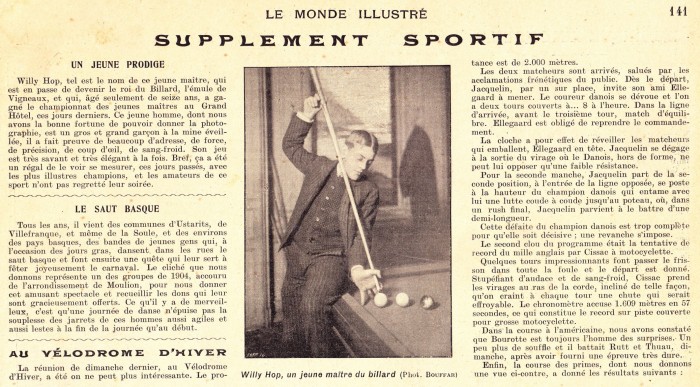
Het was gebruikelijk dat er weddenschappen werden afgesloten op de wedstrijden aldaar. Deze werden bijgehouden door een vaste bookmaker. Tijdens een wedstrijdje "over rood” wenkte een Amerikaanse toeschouwer Willie met de woorden : ”Jongen, ik heb 500$ op je ingezet, als je wint zijn ze voor jou”. Het bleek de staalmagnaat Charles Schwab te zijn. De jonge Willie die zich al rijk rekende kreeg dermate last van de zenuwen dat hij geen punt meer kon maken.
In those days it was common to bet on matches. Every billiard room had his bookmaker. During a match "over red" in Paris an American visitor took Willie aside and said :"Boy, I just bet 500$ on you, if you win the profit is yours." The visitor was Charles Schwab the famous steel magnate. It resulted in Willie becoming so nervous that he coouldn't score a point anymore and losing the match.
In 1903 ging hij op tour met Jacob "The Wizard” Schaeffer Sr. op dat ogenblik een van de beste kaderspelers. Schaeffer Sr. was een snelle speler die op gevoel speelde, niet het type dat veel uitleg gaf of figuren uitrekende. Schaeffer was gekend voor zijn formidabele massés. Alhoewel klein van gestalte was er geen figuur op de biljarttafel die hij niet kon maken. Hij kon dan ook zowel rechts- als linkshandig perfect uit de voeten. Willie leerde weer enorm veel bij.
Hoppe went on tour in 1903 with Jacob "The Wizard" Schaeffer Sr., one of the best balkline players in the world at the time. Schaeffer Sr. was a fast and instinctive player, not the kind of guy that would calculate every point and not the kind of teacher that would explain alot. Although small in posture there was not a position he could not make as he was perfectly right and left handed. Schaeffer was known for his formidable massé shots. Again Willie was learning alot.
Op 15 januari 1906 op amper 18-jarige leeftijd deed hij te Parijs in het Grand Hotel een gooi naar het wereldkampioenschap kader 45/1 naar 500 punten tegen de Franse grootmeester Maurice Vignaux die toen vooraan in de 60 was. Comte de Drée, een biljartautoriteit, was scheidsrechter. Bij de rustpauze stond het 266 – 228 voor Vignaux. Uiteindelijk won Hoppe met 500 – 322 met een gemiddelde van 20,83 en 14,04 voor Vignaux. Hoppe ging met $5.000 aan prijzengeld en fooien naar huis.
On January 15 1906, only 18 years old, Hoppe challenged the French icon, Maurice Vignaux, who was in his early 60ies for the world title balkline 18/1. Comte de Drée, one of the leading figures in the billiard world and once president of the French billiard league, was the referee. At mid game Vignaux was leading 266-228. At the end Hoppe won 322-500 in 24 innings averaging 20,83 against 14,04 for Vignaux. Hoppe went home with 5.000 $ of price money and tips.
Foto : 15 januari 1906 Willie Hoppe speelt tegen Maurice "Le Lion" Vignaux voor de wereldtitel kader 45/1 in de balzaal van het Grand Hotel te Parijs. Links rechtstaand de scheidsrechter Comte de Drée met de handen in de zakken.
Photo : At the left, hands in his pockets, Comte de Drée the referee and the 2 contenders, Willie "Boy Wonder" and Maurice "The Lion" Vignaux.
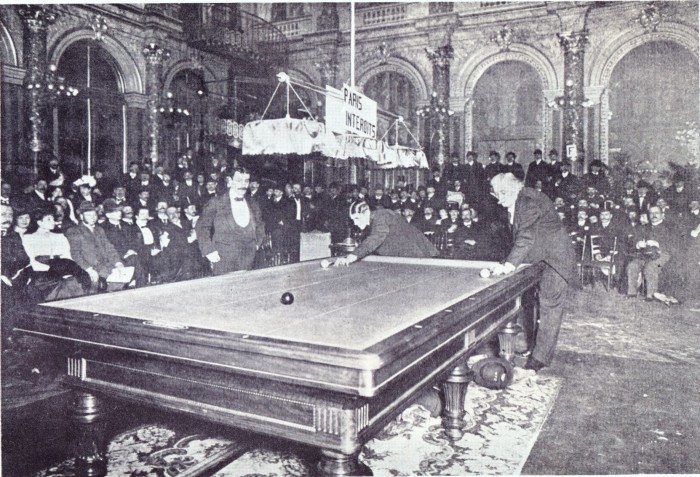
Zijn carrière was definitief gelanceerd en hij zou meerdere malen wereldkampioen worden in het kaderspel. De waarde van een wereldtitel op jaarbasis werd geschat tussen de $20.000 en $50.000, voor die tijd enorme bedragen. Tussendoor werd hij nog uitgenodigd voor een demonstratie in het Witte Huis voor president Taft in 1911. In de jaren dat Hoppe nog kader speelde zou Edouard Horemans nog een opgemerkte entrée maken in het wereldje van de professionals. Horemans werd wereldkampioen in de jaren 1925 en 1928.
This match launched Hoppe's career at rocket speed and as from that time he would win many world titles. The value of a world title on a year's basis was estimated between 20.000$ and 50.000$ at the time, enormous amounts. In 1911 he was invited by president Taft to give an exhibition at the White House. Sponsored by the Brunswick-Balke-Collender company the world championships for professionals were mostly played in the U.S. with American player. Our Belgian player Edouard Horemans was one of the few Europeans traveling to the U.S. competing for the world title. Horemans became world champion in 1925 and 1928.
Foto : vlnr. De Belg Edouard Horemans, Welker Cochran, Kinrey Matsuyami, Willie Hoppe en de Fransman Felix Grange.
Verwoede tegenstanders in het kaderspel.
Photo : from left to right Belgian Edouard Horemans, Welker Cochran, Kinrey Matsuyami, Willie Hoppe and French Felix Grange.
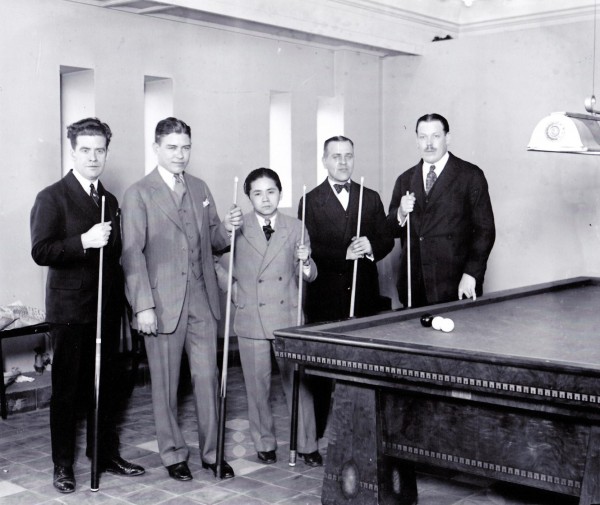
Vanaf het midden van de jaren ’30 richtte Hoppe zijn focus op het driebanden. Tot en met het einde van de jaren ’30 was het Welker Cochran die overheerste maar vanaf de jaren ’40 tot 1952 zwaaide Hoppe de plak en behaalde hij regelmatig tornooigemiddelden van boven de 1,000. De gemiddelden zijn echter niet altijd 100% te vergelijken met de huidige. In 1944 veranderde men het reglement en mocht je tijdens de wedstrijd de speelbal van je voorkeur kiezen (wit of geel, maakt niet uit) bovendien werd 1 strafpunt gegeven voor een opzettelijke verdedigingsstoot (een figuur dat nooit tot een drieband kan leiden) en 5 strafpunten voor 2 opeenvolgende verdedigingsstoten.
As from the mid-thirties Hoppe changed his focus to 3-cushion billiards. Welker Cochran was the best 3-cushion player in thirties, but as from 1940 until his retirement in 1952 Hoppe would dominate the 3-cushion field and played tournament averages over 1,000 on a regular basis. Although its hard to compare these averages with the current ones as the rules were not always the same as nowadays. E.g. in 1944 there was such a change where could pick your ball of choice (except for the red) and negative defensive play got penalised.
Op het internet vind je nog redelijk wat filmpjes over zijn optredens waar je zijn hele karakteristieke en weinig orthodoxe zijdelingse afstoot kan bekijken. Ook karakteristiek aan Willie Hoppe was de vingerzetting van de voorhand, de befaamde "tripod". Willie's gouden handen waren verzekerd voor een bedrag van 100.000 $.
On the internet you still can find some footage of his exhibitions where you can notice his particular "side strike" holding his hand away from his body and his wonderful finger setting called the "tripod". Willie's golden hand were insured for an amount of 100.000$.
Foto's : Willie's gouden hand en unieke vingerzetting "The Tripod". - Willie's golden and well insured hand showing one of his trademarks "The Tripod"
|
Onderstaande foto en de tekst rechts zijn originelen van de Chicago Tribune. Pre-press materiaal, vandaar het kadertje op de foto en rechts een beknopte uitleg. Photo below and text at the right are originals from the Chicago Tribune. Pr-press material, hence the little tapered frame below.
|
|
Een van de merkwaardigste wedstrijden die Hoppe zou spelen was tegen Robert Cannefax in 1925. Cannefax was in die periode de topper in het driebanden. Vanaf 1917 had hij reeds 6 wereldtitels bij de profs gewonnen. Hoppe's focus lag toen nog op het kaderspel, toch kon hij op die dag Cannefax de baas in het driebanden. Cannefax die de tafel te traag vond vroeg om op een andere tafel verder te spelen of om het laken te veranderen. Toen Hoppe daar niet op inging sneed Cannefax van pure colère het laken aan flarden met een zakmes. De winst ging naar Hoppe en Cannefax werd voor 1 jaar geschorst. Robert stapte echter in de vaudeville en zou niet meer terugkeren naar het biljartspel. In 1928 stierf hij aan een hersenvliesontsteking. Cannefax was een bijzonder kleurrijke figuur. Een ziekte had er eerder toegeleid dat zijn been geamputeerd moest worden en in de plaats kreeg hij een houten protese. Om tegenstanders te intimideren haalde hij dat zelfde zakmes al eens boven tijdens een wedstrijd om er dan mee in zijn houten been te steken.
The most remarkable game Hoppe would ever play was the one against Robert Cannefax in 1925. At that time Cannefax was an ace 3-cushion player. From 1917 on he already won 6 world titles in the professional league. Hoppe's focus at the time was still with balkline but that day he proved to be the better 3-cushion player. Cannefax complained that the table was too slow and demanded to play along on another table or to change the cloth. Hoppe refused resulting in Cannefax taking out a penknife and cutting the cloth to shreds in a rage. Hoppe was crowned the winner and Cannefax was banned from playing billiards for a year. Robert entered in vaudeville and would never return to the game of billiards. In 1928 he would die from meningitis. Cannefax was a very colorful figure, to say the least. A disease in his younger life led to the amputation of his leg and he got a wooden prothese. When matches were not going as expected, from time to time he would take out his penknife and stick it in his wooden leg to intimidate his adversaries.
Foto : Cannefax rechts met WC Fields de briljante komiek. Een prachtige parodie van Fields op het biljartspel vind je op
Photo : Robert Cannefax at the right with the brilliant comedian WC Fields. Watch WC Fields hilarious view on billiards: Music - Humor - Art
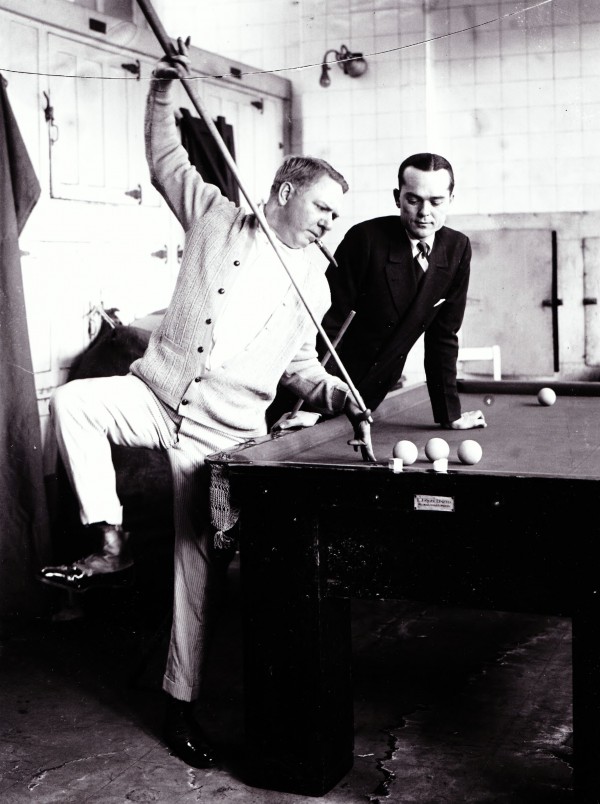
Foto : vlnr. Johnny Layton, Otto Reiselt en August Kieckhefer.
Topspelers, allen ooit wereldkampioen bij de profs die Hoppe meermaals het vuur aan de schenen legden in het driebanden.
Photo below from left to right: Johnny Layton, Otto Reiselt and August Kieckhefer (read also August Kieckhefer - °1889 )
All 3-cushion world champions who competed many times with Hoppe
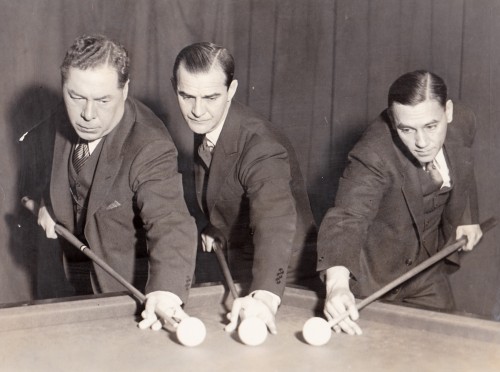
In 1941 wordt zijn tweede boek "Billiards As it should be played” uitgegeven. Het is een prachtig boek dat je nog te koop kan vinden op het internet als je wat geduld hebt. Het bevat een hele resem aan foto’s en figuren vergezeld van hele duidelijke uitleg. Het is meerdere malen heruitgegeven in verschillende maten en vormen. Er bestaat bijvoorbeeld een recentere versie bewerkt door Francis Connesson. Het boek bespreekt alle aspecten van het biljartspel met de nadruk op het driebanden waaronder het "Diamond System”. Hoppe zou dit zelf niet of nauwelijks toegepast hebben. Het biljarten zat er bij hem zo van kinds af aan ingebakken dat hij alle figuren op gevoel kon spelen. Hij hechtte veel belang aan concentratie, focus en een goede voorbereiding. Uit zijn boek blijkt dat hij er de voorkeur aan gaf om met beperkt of geen effect te spelen.
In 1941 he wrote his second book "Billiards As it should be played". It is an interesting book that still is sold on the internet at prices ranging from 15- 75$. It exists in many editions and formats. There is also a more recent French edition on the market "co-authored" by Francis Connesson. The book contains many diagrams with a clear explanation. It handles many aspects of carom billiards with an emphasis on 3-cushion billiards. Also the diamond system is explained. Sources say that Willie did not author this part and certainly was not an adept of calculating the trajectory of the cue ball. Playing from such a young age, training every day, his natural instinct was so strong it wasn't necessary. Hoppe hammered on concentration, focus and a good preparation. In the book you can see he mostly played with no to little english (effect).
Foto's : Covers van Willie Hoppe's boeken. Let op de "zijdelingse" afstoot, een gevolg van het starten met biljarten als erg jong kereltje toen hij nog amper met zijn armen boven het biljart kon uitkomen.
Covers of the books Willie Hoppe wrote. In reality the format of the book at the right is bigger than the book at the left.
|
|
|
Net voor de uitgave van het boek wordt er in de LIFE magazine van 21 april 1941 een artikel aan Hoppe besteed met nadruk op de fotografie van meerdere figuren. Met behulp van een stroboscopisch fototoestel worden figuren over hun ganse beweging vastgelegd waarbij je perfect de looplijnen van de drie ballen kan zien. Wat opvalt is dat de baan van de ballen vaak parabolisch is en pas na enige tijd overgaan in een rechte lijn.
Just before the book "Billiards As it should played" got edited, in LIFE magazine from April 21 1941 an article is published with many spectacular photo's using a stroboscopic effect in order to be able to follow the whole trajectory of all 3 balls. The photo's show that the trajectory of the balls (mainly the cue balls) is at many times (after impact with another ball or a cushion) parabolic afterwards transferring in a straight line. Mathematicians as Johann Albrecht Euler and Gaspard Gustave Coriolis already studied these effects in the 18th and 19th century.
In een uitgave van het Popular Mechanics magazine van 1946 werd heel deze oefening nog eens overgedaan met behulp van stroboscopisch lampen die elke 2 miljoenste van een seconde aan- en uitsprongen en een Speed Graphic camera met open sluiters.
In an edition of Popular Mechanics dating from 1946 the same experience was repeated with stroboscip lamps flickering every 2 millionth of a second in combination with a Speed Graphic Camera with open shutters.
Photo : the installation needed to get the photo's shown in Popular Mechanics in 1946.
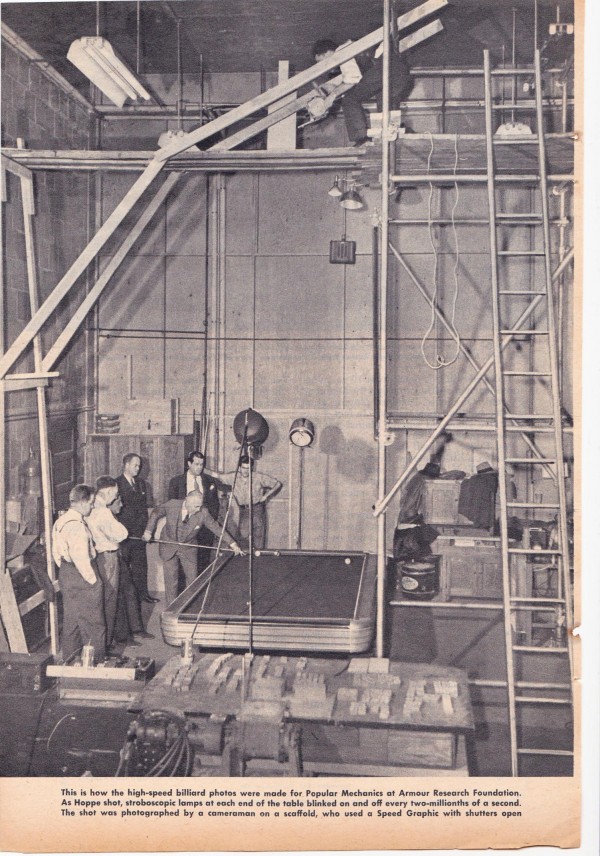
Foto : Stroboscopische foto uit Popular Mechanics van 1946
Photo : One of those famous "strobscopic" photo's
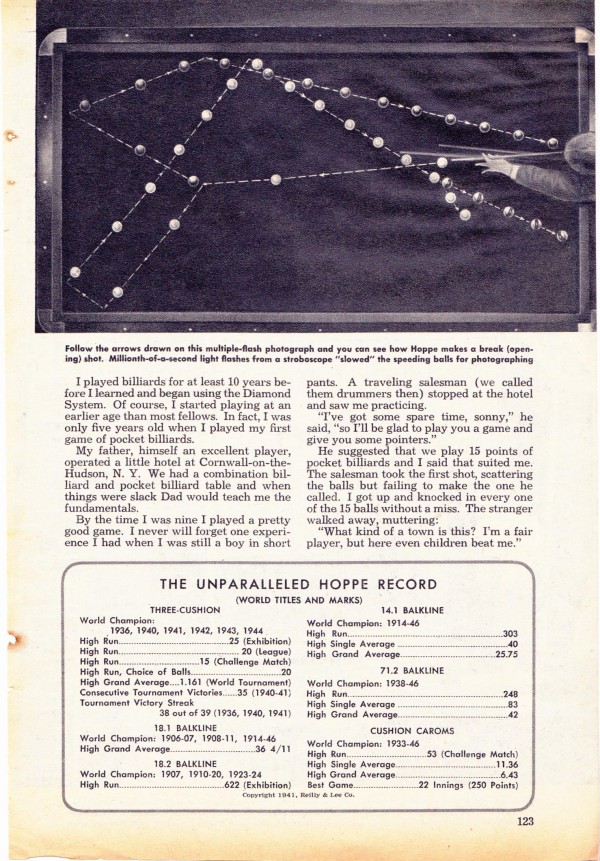
In 1949 speelde Hoppe een opgemerkte exhibitiewedstrijd tegen Ezequiel Navarra in Buenos Aires. Hoppe verloor de tiendaagse naar 1.500 punten driebanden tegen de jongere Navarra met 1500 – 1216 in 1212 beurten. De nacht van de finale werd er gespeeld voor meer dan 4.000 toeschouwers. Het Argentijnse biljart was toen al een tijdje aan een steile opmars bezig met epigonen als Leopoldo Carrera en de gebroeders Navarra.
In 1949 Hoppe went over to Buenos Aires, in Argentina,to play a series of remarkable matches against Argentinian Ezequiel Navarra. In the end Hoppe would lose the 10-day contest against the younger Navarra 1500-1216 in 1212 innings. The night of the final more than 4.000 spectators assisted to this epic match. Carom billiards was becoming very popular in Argentina with iconic players as the Navarra brothers, their cousin Enrique and most of all Pedro Leopoldo Carrera.
Foto : De finale nacht van juli 1949 in het Luna Park te Buenos Aires:
Photo: The night of the final July 1949 at the Luna Park in Buenos Aires
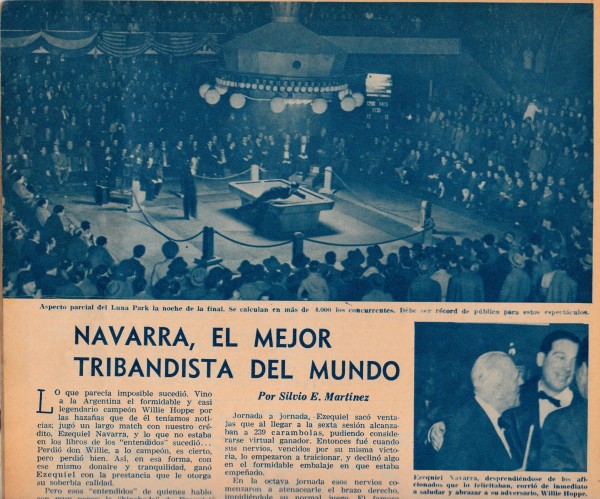
Voor de biljartliefhebbers in Argentinië was de komst van Willie het evenement van het jaar. Alle bekende biljartspelers waren er aanwezig en er werd ter ere van Hoppe een tekening gemaakt waarop alle topspelers en notabelen hun handtekening plaatsten. Dit document maakte deel uit van het "scrapbook" dat Willy bijhield en dat tot voor kort in handen was van Jim en Bon Parker van de Illinois Billiard Club en Bonnie's Dining & Banquets. Jim en Bon waren zo vriendelijk om een scan ter beschikking te stellen. Ondertussen hebben zij het scrapbook uit handen gegeven.
All billiard amateurs were looking forward to Willie coming over to Buenos Aires. To thank Willy one of the local artists made a drawing of Willy with the flags of the U.S.A. and Argentina. All famous people present at the time signed this drawing. Among them the Navarra brothers, their cousin Enrique Navarra, Pedro Leopoldo Carrera, José Bonomo and many others. I received this scan from Jim and Bon Parker who held until recently the priceless scrapbook of Willy Hoppe. They still are the thriving forces behind the Illinois Billiard Club and Bonnie's Dining & Banquets.
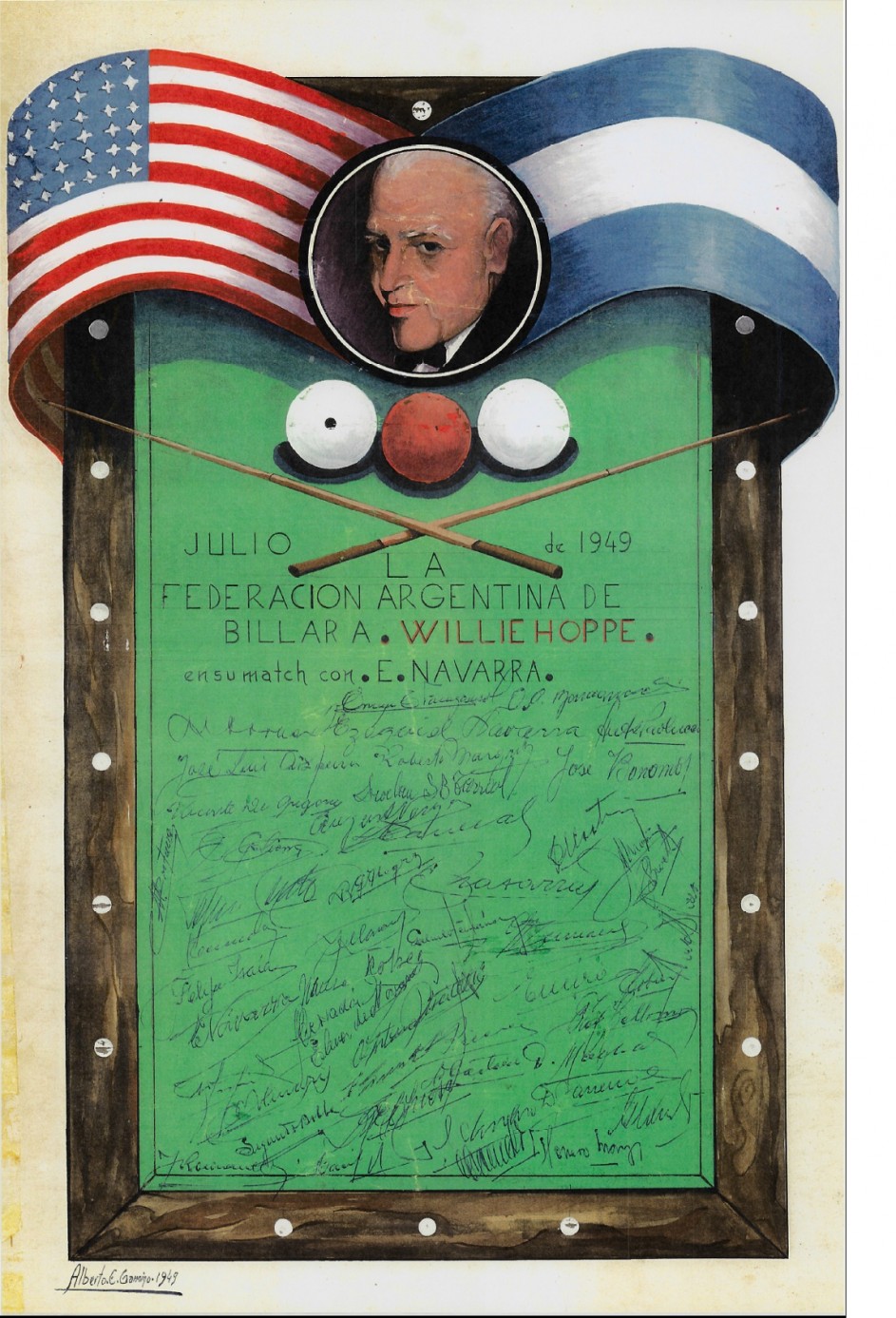
Na het gewonnen "wereldkampioenschap” van 1952 hing Willie de competitiekeu aan de haak en zou hij enkel nog exhibities spelen en wat meer van het leven genieten in Miami. Terwijl hij zijn ganse leven als een asceet had geleefd zou hij nu al eens een sigaret roken en een pint drinken. Willie trouwde en scheidde tweemaal en had een dochter Alice en een zoon William Jr bij zijn eerste vrouw Alice Walsh. Op 27 december 1923 zou hij via het gerecht het hoederecht over zijn zoon overdragen aan zijn ex-vrouw. In 1927 zou zij via het gerecht het definitieve hoederecht over beide kinderen aanvragen. Op 9 december 1946 overleed ze na een operatie.
|
Some footage to be found on YouTube
|
|
|
|
|
After winning the 1952 3-cushion world title for professionals, Willie retired, to only play exhibitions from time to time and enjoy life in Miami. Having lived a sober life during the whole of his career now he would allow himself a smoke and a pint of beer from time to time. Willie would marry and divorce 2 times and had a daughter Alice and a son William Jr. with his first wife Alice Walsh. On December 27 1923 in court custody of his son would be transferred to his ex-wife. In 1927 ALice Walsh demanded custody over both children in court. Alice Walsh would die on December 1946 after having churgery.
Zijn neef Gerald Holton, zoon van Irma Hoppe, de jongste zus van Willie, die hem regelmatig zag toen hij nog in Philadelphia woonde zou hem omschrijven als een alleraardigste gentleman. Dan McGoorty zou hem omschrijven als een gereserveerde, vriendelijke aristocraat. Willie, Mr. Billiards, altijd netjes in het pak of smoking gaf de sport zijn hoogste aanzien en glorie. Op 1 februari 1959 overleed Hoppe in Miami aan de gevolgen van een hartaanval. Enkele maanden later zou ook Welker Cochran sterven en werd er een punt gezet achter de hoogdagen van het Amerikaanse carambolebiljart. Even nog zou Sang Chun Lee een lichtje laten flikkeren in New York.
His nephew Gerard Holton, son of Irma Hoppe, Willie's youngest sister, met with uncle Willie regularly when he still lived in Philadelphia and would describe as a friendly gentleman. Dan McGoorty described him as aloof, friendly and aristocrat of billiards. Willie Hoppe, Mr. Billiards, always neatly dressed with tie or tuxedo gave the sport tremendous exposure. On February 1 1959 Willie would die. A few months later also Welker Cochran would die and suddenly the heydays of American carom billiards would come to an end. A few decades later a certain Sang Chun Lee would spark the 3-cushion fire again in New York.
Willie Hoppe stond een groot deel van zijn leven onder contract van de Brunswick Balke Collender Company, de commerciële reus in de biljartwereld van die tijd.
Most of his life Willie Hoppe was under contract with the Brunswick Balke Collender Company, the commercial giant of billiard tables, cues and accessories at the time.
Filip Steurs, 24 november 2012. Added material over time.
Translation April 4, 2015.
Bronnen : Thirty Years of Billiards by Willie Hoppe 1925, Billiards As it should be played by Willie Hoppe 1941, LIFE magazine 1941, Popular Mechanics magazine 1946, website Charles Ursitti www.charles.ursitti.com, Mundo deportivo juli 1949, El Grafico juli 1949, diverse krantenartikelen, Jim and Bon Parker van de Illinois Billiard Club
Sources : Thirty Years of Billiards by Willie Hoppe 1925, Billiards As it should be played by Willie Hoppe 1941, LIFE magazine 1941, Popular Mechanics magazine 1946, Charles Ursitti's website www.charles.ursitti.com, Mundo Deportivo July 1949, El Grafico July 1949, Dan McGoorty - A Billiard Hustler's Life by Robert Byrne 1972, many news paper articles, Jim and Bon Parker from the Illinois Billard Club
Foto : Reclame van de scheermessenfabrikant Gilette met Willie Hoppe als bron van inspiratie :-)
Drawing: Publicity campaign from Gilette showing a "razor sharp" Hoppe :-)
